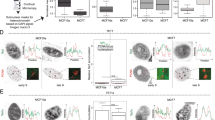Abstract
Although the roles of 5-methylcytosine and 5-hydroxymethylcytosine in epigenetic regulation of gene expression are well established, the functional effects of 5-formylcytosine and 5-carboxylcytosine on the process of transcription are not clear. Here we report a systematic study of the effects of five different forms of cytosine in DNA on mammalian and yeast RNA polymerase II transcription, providing new insights into potential functional interplay between cytosine methylation status and transcription.
This is a preview of subscription content, access via your institution
Access options
Subscribe to this journal
Receive 12 print issues and online access
$189.00 per year
only $15.75 per issue
Buy this article
- Purchase on Springer Link
- Instant access to full article PDF
Prices may be subject to local taxes which are calculated during checkout



Similar content being viewed by others
References
Jaenisch, R. & Bird, A. Nat. Genet. 33 (suppl.), 245–254 (2003).
Law, J.A. & Jacobsen, S.E. Nat. Rev. Genet. 11, 204–220 (2010).
Ito, S. et al. Science 333, 1300–1303 (2011).
He, Y.F. et al. Science 333, 1303–1307 (2011).
Pfaffeneder, T. et al. Angew. Chem. Int. Edn Engl. 50, 7008–7012 (2011).
Wu, H. & Zhang, Y. Genes Dev. 25, 2436–2452 (2011).
Pastor, W.A. et al. Nature 473, 394–397 (2011).
Tahiliani, M. et al. Science 324, 930–935 (2009).
Lindahl, T. & Barnes, D.E. Cold Spring Harb. Symp. Quant. Biol. 65, 127–133 (2000).
Cramer, P., Bushnell, D.A. & Kornberg, R.D. Science 292, 1863–1876 (2001).
Wang, D., Bushnell, D.A., Westover, K.D., Kaplan, C.D. & Kornberg, R.D. Cell 127, 941–954 (2006).
Shukla, S. et al. Nature 479, 74–79 (2011).
Pinto, P.A. et al. EMBO J. 30, 2431–2444 (2011).
Core, L.J. & Lis, J.T. Science 319, 1791–1792 (2008).
de la Mata, M. et al. Mol. Cell 12, 525–532 (2003).
McDowell, J.C., Roberts, J.W., Jin, D.J. & Gross, C. Science 266, 822–825 (1994).
Maiti, A. & Drohat, A.C. J. Biol. Chem. 286, 35334–35338 (2011).
Cortellino, S. et al. Cell 146, 67–79 (2011).
Cortázar, D. et al. Nature 470, 419–423 (2011).
Tini, M. et al. Mol. Cell 9, 265–277 (2002).
Werner, F. & Grohmann, D. Nat. Rev. Microbiol. 9, 85–98 (2011).
Nudler, E. Annu. Rev. Biochem. 78, 335–361 (2009).
Conaway, J.W., Shilatifard, A., Dvir, A. & Conaway, R.C. Trends Biochem. Sci. 25, 375–380 (2000).
Shilatifard, A., Conaway, J.W. & Conaway, R.C. Curr. Opin. Genet. Dev. 7, 199–204 (1997).
Serizawa, H., Conaway, R.C. & Conaway, J.W. J. Biol. Chem. 268, 17300–17308 (1993).
Dai, Q. & He, C. Org. Lett. 13, 3446–3449 (2011).
Sidorenkov, I., Komissarova, N. & Kashlev, M. Mol. Cell 2, 55–64 (1998).
Kireeva, M.L., Komissarova, N., Waugh, D.S. & Kashlev, M. J. Biol. Chem. 275, 6530–6536 (2000).
Johnson, K.A., Simpson, Z.B. & Blom, T. Anal. Biochem. 387, 20–29 (2009).
Johnson, K.A., Simpson, Z.B. & Blom, T. Anal. Biochem. 387, 30–41 (2009).
Venter, J.C. et al. Science 291, 1304–1351 (2001).
Romiguier, J., Ranwez, V., Douzery, E.J. & Galtier, N. Genome Res. 20, 1001–1009 (2010).
Sentürker, S. et al. FEBS Lett. 416, 286–290 (1997).
Acknowledgements
D.W. acknowledges support from the US National Institutes of Health (GM085136), start-up funds from the Skaggs School of Pharmacy and Pharmaceutical Sciences at the University of California, San Diego, and the Kimmel Scholar Award from the Sidney Kimmel Foundation for Cancer Research. C.H. acknowledges the National Institutes of Health for support (GM071440). We thank J. Conaway and R. Conaway (Stowers Institute for Medical Research) for the generous gift of purified mammalian Pol II. We also thank E.P. Geiduschek, J.R. Halpert, X-D. Fu, B. Ren, Y. Zhang and K. Zhang for their insightful comments and critical reading of the manuscript.
Author information
Authors and Affiliations
Contributions
D.W. conceived the original idea. M.W.K., C.H. and D.W. designed the experiments. C.S. and X.L. carried out synthesis of DNA templates. J.C. and D.W. purified Pol II. M.W.K. and D.W. performed transcription assays. M.W.K. and D.W. carried out data analysis. M.W.K., J.C., C.H. and D.W. wrote the paper.
Corresponding author
Ethics declarations
Competing interests
The authors declare no competing financial interests.
Supplementary information
Supplementary Text and Figures
Supplementary Figures 1–5, Supplementary Tables 1–3 and Supplementary Note (PDF 3097 kb)
Rights and permissions
About this article
Cite this article
Kellinger, M., Song, CX., Chong, J. et al. 5-formylcytosine and 5-carboxylcytosine reduce the rate and substrate specificity of RNA polymerase II transcription. Nat Struct Mol Biol 19, 831–833 (2012). https://doi.org/10.1038/nsmb.2346
Received:
Accepted:
Published:
Issue Date:
DOI: https://doi.org/10.1038/nsmb.2346
This article is cited by
-
Auto-suppression of Tet dioxygenases protects the mouse oocyte genome from oxidative demethylation
Nature Structural & Molecular Biology (2024)
-
LINE-1 transcription in round spermatids is associated with accretion of 5-carboxylcytosine in their open reading frames
Communications Biology (2021)
-
Dysregulation of 2-oxoglutarate-dependent dioxygenases by hyperglycaemia: does this link diabetes and vascular disease?
Clinical Epigenetics (2020)
-
Complete Profiling of Methyl-CpG-Binding Domains for Combinations of Cytosine Modifications at CpG Dinucleotides Reveals Differential Read-out in Normal and Rett-Associated States
Scientific Reports (2020)
-
Epigenetic dynamics in cancer stem cell dormancy
Cancer and Metastasis Reviews (2020)



